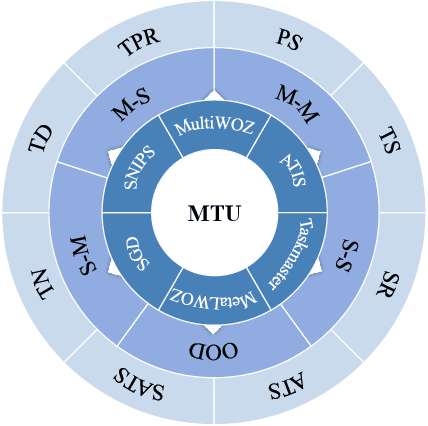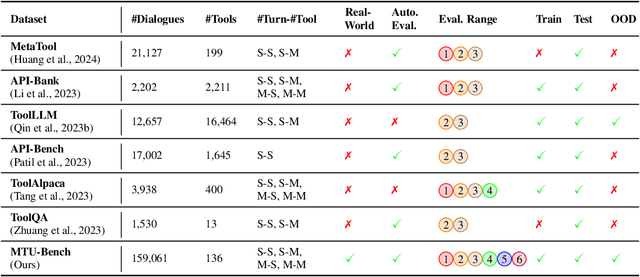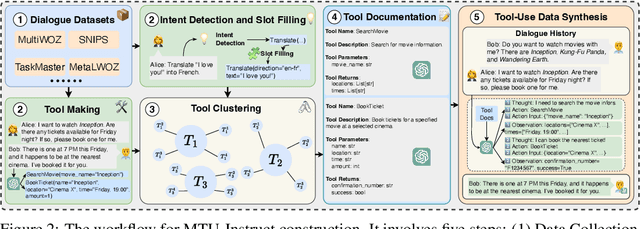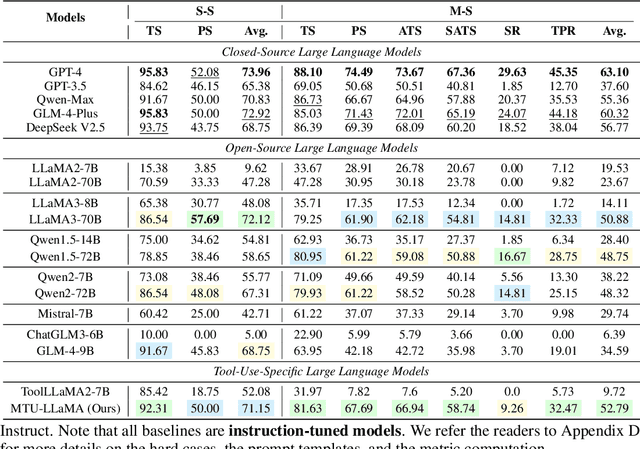Zhongyuan Peng
Can Large Language Models Detect Errors in Long Chain-of-Thought Reasoning?
Feb 26, 2025Abstract:Recently, o1-like models have drawn significant attention, where these models produce the long Chain-of-Thought (CoT) reasoning steps to improve the reasoning abilities of existing Large Language Models (LLMs). In this paper, to understand the qualities of these long CoTs and measure the critique abilities of existing LLMs on these long CoTs, we introduce the DeltaBench, including the generated long CoTs from different o1-like models (e.g., QwQ, DeepSeek-R1) for different reasoning tasks (e.g., Math, Code, General Reasoning), to measure the ability to detect errors in long CoT reasoning. Based on DeltaBench, we first perform fine-grained analysis of the generated long CoTs to discover the effectiveness and efficiency of different o1-like models. Then, we conduct extensive evaluations of existing process reward models (PRMs) and critic models to detect the errors of each annotated process, which aims to investigate the boundaries and limitations of existing PRMs and critic models. Finally, we hope that DeltaBench could guide developers to better understand the long CoT reasoning abilities of their models.
CodeCriticBench: A Holistic Code Critique Benchmark for Large Language Models
Feb 23, 2025Abstract:The critique capacity of Large Language Models (LLMs) is essential for reasoning abilities, which can provide necessary suggestions (e.g., detailed analysis and constructive feedback). Therefore, how to evaluate the critique capacity of LLMs has drawn great attention and several critique benchmarks have been proposed. However, existing critique benchmarks usually have the following limitations: (1). Focusing on diverse reasoning tasks in general domains and insufficient evaluation on code tasks (e.g., only covering code generation task), where the difficulty of queries is relatively easy (e.g., the code queries of CriticBench are from Humaneval and MBPP). (2). Lacking comprehensive evaluation from different dimensions. To address these limitations, we introduce a holistic code critique benchmark for LLMs called CodeCriticBench. Specifically, our CodeCriticBench includes two mainstream code tasks (i.e., code generation and code QA) with different difficulties. Besides, the evaluation protocols include basic critique evaluation and advanced critique evaluation for different characteristics, where fine-grained evaluation checklists are well-designed for advanced settings. Finally, we conduct extensive experimental results of existing LLMs, which show the effectiveness of CodeCriticBench.
SuperGPQA: Scaling LLM Evaluation across 285 Graduate Disciplines
Feb 20, 2025Abstract:Large language models (LLMs) have demonstrated remarkable proficiency in mainstream academic disciplines such as mathematics, physics, and computer science. However, human knowledge encompasses over 200 specialized disciplines, far exceeding the scope of existing benchmarks. The capabilities of LLMs in many of these specialized fields-particularly in light industry, agriculture, and service-oriented disciplines-remain inadequately evaluated. To address this gap, we present SuperGPQA, a comprehensive benchmark that evaluates graduate-level knowledge and reasoning capabilities across 285 disciplines. Our benchmark employs a novel Human-LLM collaborative filtering mechanism to eliminate trivial or ambiguous questions through iterative refinement based on both LLM responses and expert feedback. Our experimental results reveal significant room for improvement in the performance of current state-of-the-art LLMs across diverse knowledge domains (e.g., the reasoning-focused model DeepSeek-R1 achieved the highest accuracy of 61.82% on SuperGPQA), highlighting the considerable gap between current model capabilities and artificial general intelligence. Additionally, we present comprehensive insights from our management of a large-scale annotation process, involving over 80 expert annotators and an interactive Human-LLM collaborative system, offering valuable methodological guidance for future research initiatives of comparable scope.
A Comparative Study on Reasoning Patterns of OpenAI's o1 Model
Oct 17, 2024



Abstract:Enabling Large Language Models (LLMs) to handle a wider range of complex tasks (e.g., coding, math) has drawn great attention from many researchers. As LLMs continue to evolve, merely increasing the number of model parameters yields diminishing performance improvements and heavy computational costs. Recently, OpenAI's o1 model has shown that inference strategies (i.e., Test-time Compute methods) can also significantly enhance the reasoning capabilities of LLMs. However, the mechanisms behind these methods are still unexplored. In our work, to investigate the reasoning patterns of o1, we compare o1 with existing Test-time Compute methods (BoN, Step-wise BoN, Agent Workflow, and Self-Refine) by using OpenAI's GPT-4o as a backbone on general reasoning benchmarks in three domains (i.e., math, coding, commonsense reasoning). Specifically, first, our experiments show that the o1 model has achieved the best performance on most datasets. Second, as for the methods of searching diverse responses (e.g., BoN), we find the reward models' capability and the search space both limit the upper boundary of these methods. Third, as for the methods that break the problem into many sub-problems, the Agent Workflow has achieved better performance than Step-wise BoN due to the domain-specific system prompt for planning better reasoning processes. Fourth, it is worth mentioning that we have summarized six reasoning patterns of o1, and provided a detailed analysis on several reasoning benchmarks.
MTU-Bench: A Multi-granularity Tool-Use Benchmark for Large Language Models
Oct 15, 2024



Abstract:Large Language Models (LLMs) have displayed massive improvements in reasoning and decision-making skills and can hold natural conversations with users. Recently, many tool-use benchmark datasets have been proposed. However, existing datasets have the following limitations: (1). Insufficient evaluation scenarios (e.g., only cover limited tool-use scenes). (2). Extensive evaluation costs (e.g., GPT API costs). To address these limitations, in this work, we propose a multi-granularity tool-use benchmark for large language models called MTU-Bench. For the "multi-granularity" property, our MTU-Bench covers five tool usage scenes (i.e., single-turn and single-tool, single-turn and multiple-tool, multiple-turn and single-tool, multiple-turn and multiple-tool, and out-of-distribution tasks). Besides, all evaluation metrics of our MTU-Bench are based on the prediction results and the ground truth without using any GPT or human evaluation metrics. Moreover, our MTU-Bench is collected by transforming existing high-quality datasets to simulate real-world tool usage scenarios, and we also propose an instruction dataset called MTU-Instruct data to enhance the tool-use abilities of existing LLMs. Comprehensive experimental results demonstrate the effectiveness of our MTU-Bench. Code and data will be released at https: //github.com/MTU-Bench-Team/MTU-Bench.git.
RoleLLM: Benchmarking, Eliciting, and Enhancing Role-Playing Abilities of Large Language Models
Oct 01, 2023



Abstract:The advent of Large Language Models (LLMs) has paved the way for complex tasks such as role-playing, which enhances user interactions by enabling models to imitate various characters. However, the closed-source nature of state-of-the-art LLMs and their general-purpose training limit role-playing optimization. In this paper, we introduce RoleLLM, a framework to benchmark, elicit, and enhance role-playing abilities in LLMs. RoleLLM comprises four stages: (1) Role Profile Construction for 100 roles; (2) Context-Based Instruction Generation (Context-Instruct) for role-specific knowledge extraction; (3) Role Prompting using GPT (RoleGPT) for speaking style imitation; and (4) Role-Conditioned Instruction Tuning (RoCIT) for fine-tuning open-source models along with role customization. By Context-Instruct and RoleGPT, we create RoleBench, the first systematic and fine-grained character-level benchmark dataset for role-playing with 168,093 samples. Moreover, RoCIT on RoleBench yields RoleLLaMA (English) and RoleGLM (Chinese), significantly enhancing role-playing abilities and even achieving comparable results with RoleGPT (using GPT-4).
 Add to Chrome
Add to Chrome Add to Firefox
Add to Firefox Add to Edge
Add to Edge